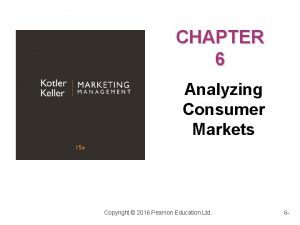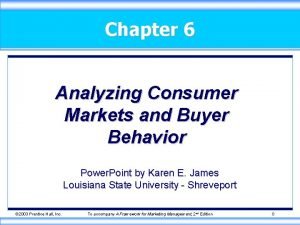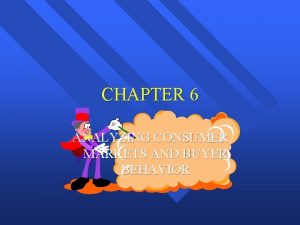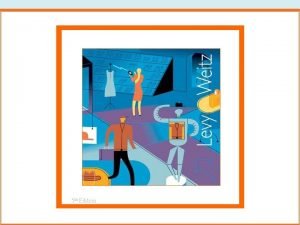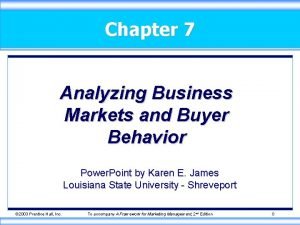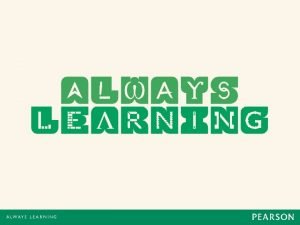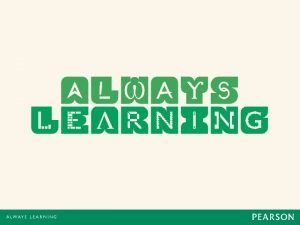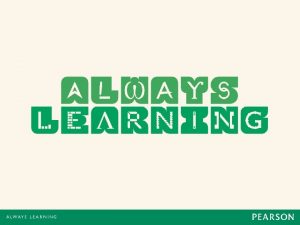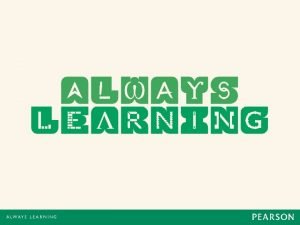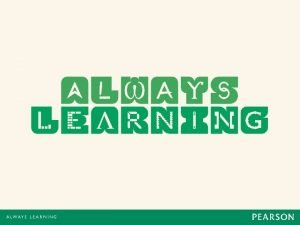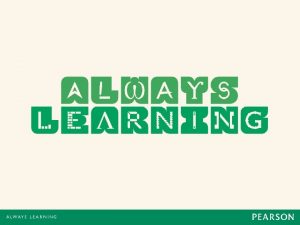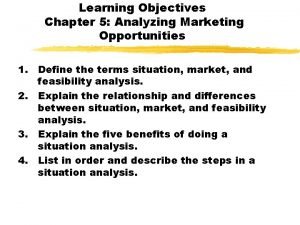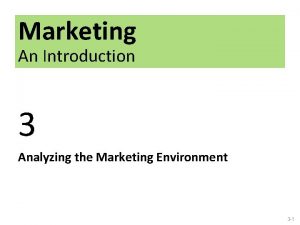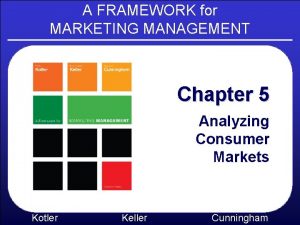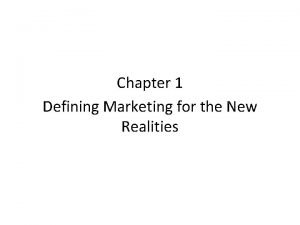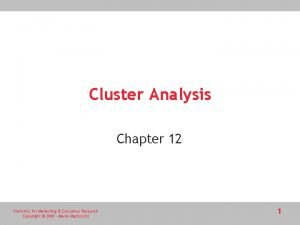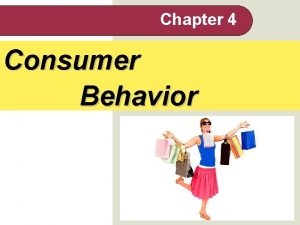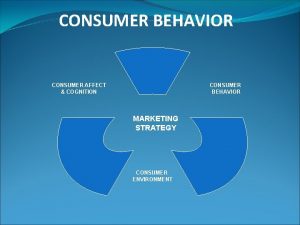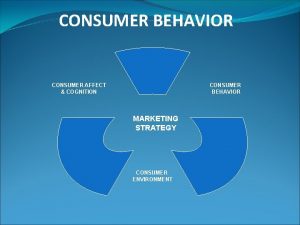MARKETING MANAGEMENT 12 th edition 6 Analyzing Consumer








































- Slides: 40

MARKETING MANAGEMENT 12 th edition 6 Analyzing Consumer Markets Kotler Keller

Chapter Questions • How do consumer characteristics influence buying behavior? • What major psychological processes influence consumer responses to the marketing program? • How do consumers make purchasing decisions? • How do marketers analyze consumer decision making? 2

Emerging Trends in Consumer Behavior Metrosexual – Straight urban man who enjoys shopping and using grooming products 3

What Influences Consumer Behavior? Cultural Factors Social Factors Personal Factors 4

Culture The fundamental determinant of a person’s wants and behaviors acquired through socialization processes with family and other key institutions 5

Subcultures Nationalities Religions Racial groups Geographic regions Special interests 6

Insight into the subculture of wine enthusiasts 7

Fast Facts About American Culture • The average American: – chews 300 sticks of gum a year – goes to the movies 9 times a year – takes 4 trips per year – attends a sporting event 7 times each year 8

Social Classes Upper uppers Lower uppers Upper middles Middle class Working class Upper lowers Lower lowers 9

Characteristics of Social Classes • Within a class, people tend to behave alike • Social class conveys perceptions of inferior or superior position • Class may be indicated by a cluster of variables (occupation, income, wealth) • Class designation is mobile over time 10

Social Factors Reference groups Family Social roles Statuses 11

Reference Groups Membership groups Primary groups Secondary groups Aspirational groups Dissociative groups 12

Family • Family of Orientation – Religion – Politics – Economics • Family of Procreation – Everyday buying behavior 13

Targeting Women and Their Families 14

Roles and Statuses What degree of status is associated with various occupational roles? 15

Personal Factors Age Selfconcept Life cycle stage Lifestyle Occupation Values Wealth Personality 16

Behavior changes according to life cycle stage • Family • Psychological • Critical life events 17

Brand Personality Sincerity Excitement Competence Sophistication Ruggedness 18

Lifestyle Influences Multi-tasking Time-starved Money-constrained 19

Figure 6. 1 Model of Consumer Behavior 20

Key Psychological Processes Motivation Perception Learning Memory 21

Motivation Freud’s Theory Maslow’s Hierarchy of Needs Behavior is guided by subconscious motivations Behavior is driven by lowest, unmet need Herzberg’s Two-Factor Theory Behavior is guided by satisfiers and dissatisfiers 22

Maslow’s Hierarchy of Needs 23

Herzberg’s Two-Factor Theory 24

Perception Selective Attention Selective Retention Selective Distortion Subliminal Perception 25

Figure 6. 3 Dole Mental Map 26

Encoding Brand Associations 27

Figure 6. 4 Consumer Buying Process Problem Recognition Information Search Evaluation Purchase Decision Postpurchase Behavior 28

Problem Recognition 29

Sources of Information Personal Commercial Public Experiential 30

Figure 6. 5 Successive Sets 31

Evaluation of Attributes Table 6. 3 32

Figure 6. 6 Stages between Evaluation of Alternatives and Purchase 33

Non-compensatory Models of Choice • Conjunctive – Each brand must meet minimum cutoff standard on attribute A and attribute B and attribute C, etc. • Lexicographic – Chose brand that has the best performance on most important criterion. • Elimination-by-aspects – Eliminate brands that do not meet minimum standards of performance. 34

Perceived Risk Functional Physical Financial Social Psychological Time 35

Figure 6. 7 How Customers Use and Dispose of Products 36

Other Theories of Consumer Decision Making Involvement • Elaboration Likelihood Model • Low-involvement marketing strategies • Variety-seeking buying behavior Decision Heuristics • Availability • Representativeness • Anchoring and adjustment 37

Mental Accounting • Consumers tend to… – Segregate gains – Integrate losses – Integrate smaller losses with larger gains – Segregate small gains from large losses 38

Marketing Debate ü Is Target Marketing Ever Bad? Take a position: 1. Targeting minorities is exploitative. 2. 2. Targeting minorities is a sound 3. business practice. 39

Marketing Discussion ü What are your mental accounts? Do you have rules you employ in spending money? Do you follow Thaler’s four principles in reacting to gains and losses? 40
 What is a secondary consumer in a food chain
What is a secondary consumer in a food chain Analyzing consumer markets
Analyzing consumer markets Analyzing consumer markets ppt
Analyzing consumer markets ppt Analyzing consumer markets and buyer behavior
Analyzing consumer markets and buyer behavior Analyzing consumer markets
Analyzing consumer markets Analyzing consumer market
Analyzing consumer market Analyzing consumer markets and buyer behavior
Analyzing consumer markets and buyer behavior Analyzing consumer market
Analyzing consumer market Characteristics of consumer behaviour
Characteristics of consumer behaviour Analyzing consumer markets
Analyzing consumer markets Retail communication mix ppt
Retail communication mix ppt Analyzing consumer and business markets
Analyzing consumer and business markets Analyzing consumer markets
Analyzing consumer markets Analyzing consumer market
Analyzing consumer market Marketing management (arab world edition)
Marketing management (arab world edition) What is the value delivery process
What is the value delivery process Marketing management (arab world edition) philip kotler
Marketing management (arab world edition) philip kotler Marketing management (arab world edition)
Marketing management (arab world edition) Kotler e keller
Kotler e keller Marketing management (arab world edition) philip kotler
Marketing management (arab world edition) philip kotler Marketing management 12th edition
Marketing management 12th edition Marketing management 12th edition
Marketing management 12th edition Primary consumer
Primary consumer Cengage
Cengage Consumer behaviour research process
Consumer behaviour research process Changes in an individual's behavior arising from experience
Changes in an individual's behavior arising from experience Mis chapter 6
Mis chapter 6 Using mis (10th edition)
Using mis (10th edition) Analyzing marketing opportunities
Analyzing marketing opportunities Marketing environment case study
Marketing environment case study Analyzing and using marketing information
Analyzing and using marketing information Marketing information and customer insights
Marketing information and customer insights Analyzing the marketing environment
Analyzing the marketing environment Marketing environment introduction
Marketing environment introduction Chapter 5 analyzing the marketing environment
Chapter 5 analyzing the marketing environment Understanding marketing management
Understanding marketing management Marketing management definitions
Marketing management definitions Marketing management introduction
Marketing management introduction Defining marketing for new realities
Defining marketing for new realities Consumer direct marketing companies
Consumer direct marketing companies Marketing consumer
Marketing consumer

